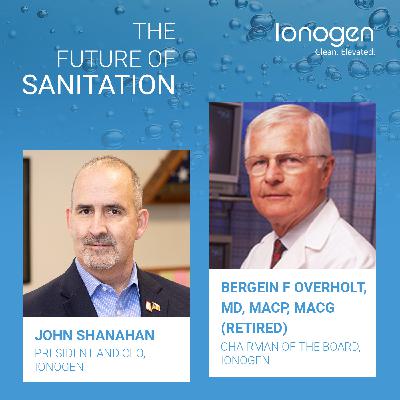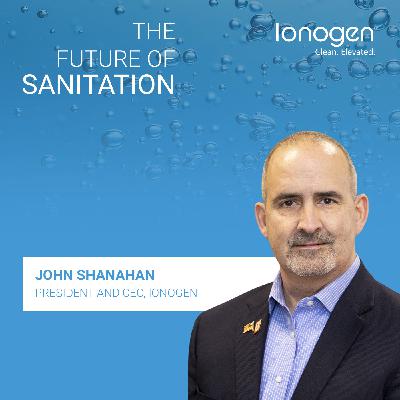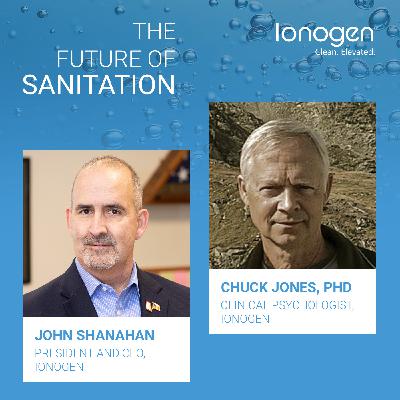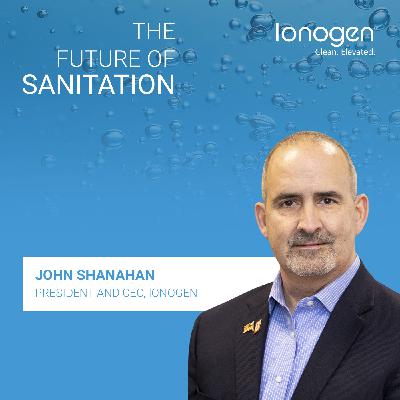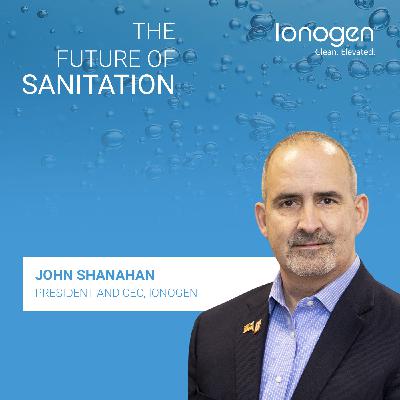Discover The Future of Sanitation by Ionogen
The Future of Sanitation by Ionogen

The Future of Sanitation by Ionogen
Author: Ionogen
Subscribed: 0Played: 6Subscribe
Share
© Copyright MarketScale
Description
Welcome to The Future of Sanitation by Ionogen. Ionogen creates the world's most powerful, non-toxic cleaners, sanitizers and disinfectants and offers innovative delivery systems for every application - from home to hospital.
15 Episodes
Reverse
As National Director of Patient Experience at Compass One Healthcare and its subsidiary, Crothall Healthcare, Grant Randall knows the importance of patient experience and satisfaction. Factors such as the perception of safety in a healthcare environment create the reality – a hospital can do everything it can to make a patient safe, but customer satisfaction scores will go down if the experience doesn’t match reality.
COVID-19 – remember when that was still a thing? Everyone thought for sure they'd be saying that by now. But, with daily cases in the U.S. reaching all-time highs and a vaccine rollout that will take much longer than desired, getting things back to a semblance of normalcy isn’t happening anytime soon.
We all want the coronavirus to go away and for COVID-19, social distancing and everything that goes with it to be remembered as a horrible part of a weird year. There are some encouraging signs, with Pfizer announcing promising news about a vaccine candidate and other medical companies making progress. But what if the vaccine isn’t effective, the virus mutates or it returns in different forms, like the flu?
Never before has American society paid as much attention to cleaning products and hygiene as it is now.
Yet, even in this heightened moment of hygiene, John Shanahan, President and CEO of Ionogen, said we’re still not doing even close to enough research about the products being used – and often overused – during the COVID-19 pandemic. While the N list distributed by the EPA is a list of all products it expects to kill the novel coronavirus SARS-CoV-2, there are knock-on effects not being considered, according to Shanahan.
“The N list is this new ‘Gucci’ line. If you’re an N-listed product, you’re effective against the COVID virus. It’s very interesting. The EPA and FDA are agencies set aside to help us. They’re supposed to protect us, they’re supposed to keep us safe. What the EPA neglects to tell us is many products listed on the N list are toxic to human health,” Shanahan said. “We know we have to deal with this issue of COVID … We look to these venerable agencies and say please give us the guidance to protect us and keep us safe, and there are products like quaternary disinfectants.”
Too often, facility managers simply assume something is good because it’s approved for use by government agencies, yet this can set up an employer for serious financial damages in the future if employees are harmed.
“The way to understand the finances and the financial damage is we have to have a realistic example of some prior precedent,” Shanahan said. “The prior precedent was set up in the three separate lawsuits that involved Roundup as an herbicide approved by the EPA.”
In those cases, the place of employment is party to the lawsuit in addition to the manufacturer. That’s why checking safety data sheets and choosing non-toxic cleaning products can be essential.
Many office buildings’ back-to-work strategy during the coronavirus pandemic has centered on frequent cleaning of surfaces. Yet, because of how the virus works, we know that likely isn’t enough to prevent the spread of COVID-19.
“The virus was originally thought to be hand-to-mouth, from surface to hand to mouth, transmission from one person to another,” Dr. Gene Overholt said. “But recent medical literature now almost conclusively says that the majority of the spread is through the air.
“We now know, with a sneeze or a cough, even regular talking and certainly loud talking, we’ll see the virus expelled from the person in small droplets, some very small, some a little larger. The large droplets settle on the surface, and the smaller ones stay suspended in the air for a number of hours.”
That poses a big challenge for traditional cleaning products, since they’re able to clean things like doorknobs, tables or elevator buttons but not the air.
“The traditional chemistry companies don’t think of the air as something you can deal with,” Ionogen CEO John Shanahan said. “It’s a mechanically complex piece, because either I make a poison or I make a filter, and either one is not going to solve the problem of COVID hanging out in the elevator lobby of a bank building. We must have another way to put something in the air, leave it in the air and be effective at killing COVID without the side effect of killing us.”
Shanahan and Overholt are testing a non-toxic hypochlorous solution that would be put into the air by a process similar to a humidifier and may be ready as soon as later this month.
“Our goal is to allow business to get back to business in as normal a way as possible,” Overholt said. “We’re all anxious to get back, but it’s got to be done in a safe, effective way. This dry fogging introduces that way.”
There are places we think of as clean and places we think of as less hygienic.
Adella Thompson, an experienced horse trainer and enthusiast, has no doubt which category her favorite place is in.
“I work in a barn,” Thompson said. “There’s a lot of manure and urine. There are horses everywhere. There are dogs everywhere. It’s a setting where you’re constantly cleaning out stalls, cleaning and grooming horses, feeding horses, watering horses, using buckets over and over again, and then caring for their medical needs.”
While pet owners are used to tricking their pooch or kitten into hopping in the car for a trip to the vet, a horse requires a vet to make house calls. That’s why Thompson, and many other horse-lovers, have learned so many tricks and tips on how to care for horses and take care of the smaller nicks and cuts suffered rather than constantly having a vet come to the stable.
Not long ago, Thompson noticed one of her horses suffered an injury at a show that required some attention. Fortunately, she had been turning to Ionogen products for some time and knew of a quick fix.
“She had a cut over her left eye. It didn’t require stitches, but it was deep, and it was bleeding. I immediately sprayed it with Ionopure Pet Health, and I watched the cut heal itself on its own,” she said.
John Shanahan, President and CEO of Ionogen, was pleased to hear of the product’s uses in the equine community, even if it wasn’t a use case he initially had in mind.
“We created Ionopure Pet Health because there was a gap for household pets in having products that could really be effective on things like hotspots, cuts and abrasions, and even rinsing the eyes and things like that,” he said. “There were other products that kind of existed in the space, but, in our opinion, they were too underpowered, they were too weak, and they didn’t actually perform and weren’t remaining stable enough for a long period of time.”
Ionopure Pet Health turned out not only to keep stable, but also to be effective in the stable, with its use in equine settings likely to continue for years to come.
It’s a question on nearly everyone’s mind at the moment, from parents to politicians – how will kids return to the classroom while the coronavirus pandemic continues?
For John Shanahan, Founder and CEO of Ionogen, the answer could be in devices like Purity Humidifiers and IonoMAX Misters, which he says would sanitize the air and decrease or even eliminate need for masking and social distancing.
Barring that, however, Shanahan said the janitorial staff, often neglected pre-pandemic, must be given the tools they need to succeed.
“Where Bob and Molly the custodians were once thought of as, oh yeah, those people, they’re going to have to be the most empowered, well-trained, well-focused people,” he said.
Shanahan also said we must make sure the solutions we’re deploying match the challenges we’re currently facing rather than an outdated way to think about sterilizing spaces.
“We’ve got to get to that place where we look at sanitizing not as the least important activity we do in the building, but the most important activity. But we have to do it 2020-style. We can’t simply go back and say, ‘Well, this worked in 1984, so I guess we’ll employ it today,’” he said. “The germs are getting smarter, the pathogens are getting more aggressive, and they’re moving differently around us, so the future is to embrace technology.”
Once students are back in the environment, it’s important that not only are they being kept safe physically, but that teachers and staff check in on their mental health, as well.
“I think there’s a conversation to be had when they first come back to school, certainly about the sanitizing that John’s talking about, but also in the context of, ‘Guys, what has it been like for you to have your lives disrupted in a way that no one in living memory has had their life disrupted?’,” said clinical psychologist Dr. Chuck Jones. “It’s an important conversation for teachers, school counselors, parents, us and anyone who’s involved.”
Dr. Bergein Overholt and John Shanahan, President & CEO of Ionogen, believe the majority of disinfectants and cleaning solutions used in household cleaners, hospitals, restaurants, schools and other buildings and workplaces are toxic and can lead to serious health problems.
Dr. Overholt, a leading gastrointestinal physician for over 50 years, is also concerned about the use of dangerous, caustic solutions for cleaning medical devices and other areas.
Dr. Overholt noticed rising cases of severe infections transmitted to patients by duodenoscopes. A change in cleaning method and switch to hypochlorous acid might eliminate the issue.
“The hypochlorous product we were using not only cleaned the facility better, but it improved the health of the building dramatically, long term, maintaining cleanliness not achieved before,” he said.
The number one problem Dr. Overholt and Shanahan believe is harming the disinfectant industry is a lack of honesty.
“What the public is exposed to in advertising for sanitization and disinfection is that these products everyone uses are effective and safe, and non-toxic. That’s not correct,” Overholt said.
If people looked up the safety data sheets on these cleaners, they’d discover most contain a variety of toxic chemicals. Because of the dangers of these disinfectant products, Ionogen developed a non-toxic cleaning solution using hypochlorous acid called Ionopure.
Which cleaning supplies are stocked in the janitor’s closet? Typically, that’s a decision that has been made down the org chart, if anyone is making the call at all.
Now, during the coronavirus pandemic, the buck may stop at the very top when it comes to the choice of disinfectants or cleaning products.
With public health a top priority, decision-makers need to be educating themselves, said John Shanahan, President and CEO of Ionogen.
“Building owners and managers have to start reading safety data sheets. They have to start understanding what toxins are being sprayed in their buildings,” Shanahan said. “In the case of commercial buildings and even restaurants, what they need to do is look at what innovation is here. What’s coming out of COVID that will allow them to reopen, have limited worker illness and improve the overall health of the building?”
One of those solutions is similar to innovations in swimming pools, where we’ve replaced chlorine and bleach with rock salt in order to kill bacteria and viruses.
“Now imagine if you could take the same concept and put a dry fog in a restaurant or a movie theater or in a hotel room. It’s a nice dry fog. It doesn’t look like London, but it’s a little bit of haze in the air,” Shanahan said. “Now someone comes in with the worst case of COVID or measles or tuberculous, and they sneeze or cough. Just like the swimming pool, that would take that virus out of the air, it would knock it right down so the virus can’t travel to a desktop, the virus can’t travel to me and get caught in my upper respiratory system.”
It’s on business leaders to make sure their employees and guests are safe, so research into what chemicals are present and what they do will be critical as businesses reopen.
The "casual" in "casual dining" should not refer to the restaurant's attitude towards the cleanliness of the experience. In this episode of MarketScale's Healthcare podcast, John Shanahan, president and CEO of Ionogen, sat down with host Sean Heath to discuss the recent chemical events in a popular fast-casual restaurant, how those chemicals got there in the first place, and how to protect ourselves when dining out.The process of protecting ourselves when dining begins the moment we step through the door, Shanahan said."If you walk into a restaurant and it doesn't smell clean? It isn't clean, and you shouldn't eat there," he said.The generally accepted authority on whether or not a dining environment is clean is the local health department, explained Shanahan."The standards are actually the same, uniformly, across all of them, because, in every state, the health department is the guardian that watches over these restaurants to make sure that the standards for sanitation are uniformly observed," Shanahan said.He also clarified that a shiny table is not necessarily a safely clean table."The leading national blue glass cleaner has 11 chemicals in it that you can't ingest," he said.This is not a problem that is limited to "quick-serve" restaurants. "White linen" dining experiences can come with their own dangers, as well, explained Shanahan."The linen is typically replaced at one of those, after every single guest," he said. "Especially during flu season, someone will go out and have dinner at a 4-star restaurant. They'll have the early stages of the flu and grab the salt and pepper shaker. If you're the next person at the table, you've just been introduced to that virus, because it's been left on the salt and pepper shaker."
It seems like every year, at least one foodborne outbreak terrorizes the nation, prompting Americans to throw away millions of tons of food. On this week’s podcast, food safety advocate and Ionogen president and CEO John Shanahan shared his insight into a new approach food providers are taking in order to prevent another outbreak from gripping the country.According to Shanahan, last year growers threw away $2 million worth of romaine lettuce following an E. coli outbreak. People fall ill and die from foodborne diseases all the time, which can have a negative impact on farms, restaurants, and grocery stores.“This issue of produce safety, and even meat and cheese safety, is a huge problem,” Shanahan said.When outbreaks occur, the first thought is to look to the farmer and their practices to trace the pathogen; farmers are naturally inclined to point elsewhere for the outbreak origin. It’s difficult to locate where the pathogen originates, and the responsibility could fall on packing houses, process plants, restaurants or grocery stores.But a change is underway. Operators in the food supply chain are working together to identify and prevent problems before they occur. What is bringing this unity? New technology. Now there are metering devices that farmers use to detect bacteria at their sites, keeping that infected head of lettuce from ever spreading its disease.Still, Shanahan advised that people at home should clean and sanitize their food before consumption. Contrary to popular belief, a lot of produce isn’t grown within the United States; often it’s from a different country.“Better than 40% of the produce that you eat in this country comes from overseas,” Shanahan said.He also advised to shop at the local farmer’s market where smaller growers have more control over the cleanliness of their product.It’s a great big world out there, but when you can, buy local and eat local,” Shanahan said.
Picture this: You’ve been going to the gym consistently for a few months and seeing great results. You’re shedding pounds and loving your look. But what if we told you your daily gym habit, a resolution for health, was permanently harming your body in irreversible ways?Unfortunately, this may be the ugly truth due to the harmful chemicals gyms use to disinfect machines. On this episode of MarketScale Building Management Podcast, President and CEO of Ionogen John Shanahan gives his take on the risks associated with these common gym chemicals.Shanahan explained how these toxic chemicals, known as “quaternary disinfectants,” are “endocrine disruptors.” This means hormones, be they testosterone or estrogen, are thrown out of whack, and livers and kidneys are thrown into overdrive.The saddest part of the equation? Quaternary disinfectants don’t even kill anything. To work, they must remain on the machine, in a damp state, for three to five minutes. So how do facility managers safely sanitize gym machines? Shanahan explained the straightforward solution – hypochlorous acid.A sister to bleach, hypochlorous acid is 80 times more effective than bleach, non-toxic, non-poisonous, and collapses into the water. Hypochlorous acid is already found naturally inside our bodies, produced by our white blood cells. Shanahan endorsed it completely, saying it is “..colorless, tasteless and odorless…When sprayed on machines, it is an instant kill to pathogens on the machine.” Sadly, it’s not widely adopted among gymnasiums, but gym-goers can be the change, asking staff to use this method of disinfectant.
There’s a commercial that says something to the effect, ‘When you think of clean, you think of bleach.” That’s certainly true for its use as an effective disinfectant. But for a product that’s been around such a long time, its best applications are still misunderstood. To discuss today on the podcast, host Tyler Kern sits down with John Shanahan, president and CEO of Knoxville-based Ionogen.Bleach dates back to Europe in the late 18th century when it was used for cleaning, disinfecting, and laundering white and light-colored clothing.“Bleach is a great disinfectant, but there are trade-offs: Our health, the surfaces we put it on, the buildings we used it on all became highly damaged,” Shanahan says.There are nuances to the different types of bleach, specifically when mixed with water, which becomes chlorine, also known as free available chlorine or neutral pH chlorine, he explains.“Bleach and chlorine have this sister element to it, but chlorine has been around as long as bleach, but it’s not put up in a bottle where you can keep it for a long period of time,” Shanahan says.“Now, you can generate neutral pH chlorine on-site with small devices the size of a coffee pot you can put in your building,” he continues. “This chlorine is so gentle if you were wearing a dark blue wool sports jacket, I could splash this all over you, and it would never take the color out of your coat.”Shanahan also discusses other uses for this gentle yet effective form of chlorine in this episode and shares insight on hypochlorous.
Did you know that the leading blue glass cleaner can kill you? Were you aware that the single-use wipes that many of us have in our kitchens and bathrooms are also putting our health at risk? At least, that’s what our guest today claims after years of research and industry experience.John Shanahan, President & CEO of Ionogen, was recently at a social function and was questioned by another guest who heard his latest podcast appearance and begged to differ that the products were harmful. After Shanahan read the ingredient list and then asked again if she would use the product around her four-year-old granddaughter, she had a very different take on the safety of the products.Why aren’t more Americans reading labels and what does a more practical sanitation solution look like? Shanahan’s research has pointed to single-use wipes potentially causing cancer, and yet most people aren’t aware of this because there aren’t many options to choose from. There isn’t a lot of new chemistry from product to product. Looking at the legacy brands (with 100+ years of retailing), they all use quaternary ammonium as a major ingredient, which can be extremely harmful to humans.The second problem is that these wipes are often misused. Wiping the toilet seat or bathroom counter is “like a snow plow in Chicago in January,” Shanahan said. “It just starts pushing the germs.”On this podcast, Shanahan explains how Americans are misusing both consumer-grade and commercial-level single-use wipes, why this is especially problematic for hospitals, and what the alternatives are.
Are you aware that the leading blue glass cleaner can kill you? Did you know that the leading disinfectant wipe on the market does not do anything?In this episode of the MarketScale Building Management Podcast, we speak with John Shanahan, the President and CEO of Ionogen and JPS Communications, who calls attention to some of the chemicals that we let seep into our skin on a daily basis, in our homes and schools.Shanahan points out that the chemicals that we use on a day-to-day basis to clean our homes, offices, hotels, and even schools can be extremely toxic, even deadly; unfortunately, consumers and facility management professionals alike often don’t know this. A lot of the chemicals being produced have been on the market for 50 or 60 years or have high brand recognition, so everyone assumes that these cleaning products are okay, but they actually have some very dangerous, toxic chemicals. Because it is in the cleaning realm, the government doesn’t intervene.A simple thing like cleaning windows can result in someone breathing in a high percentage of chemicals through the nose, mouth, and skin. Everything that lands on someone’s skin goes directly to the kidneys and liver, and everything someone breathes goes straight into the lungs.And about that disinfectant wipe? It’s made from Quaternary Ammonia, in many cases, which five leading universities have targeted as cancer-causing. When someone uses these wipes without gloves, it can soak up through the skin and into the body.Though it’s important to educate consumers, the burden falls on facility managers to bring safe sanitization to public spaces, especially schools. Shanahan explains further about Norovirus, why so many people are dying from the flu, how cruise ships and schools are being affected, and why Chipotle almost closed down all of its restaurants last year. If you have ever used a cleaning chemical in your workspace, you do not want to miss this valuable, lifesaving information.






